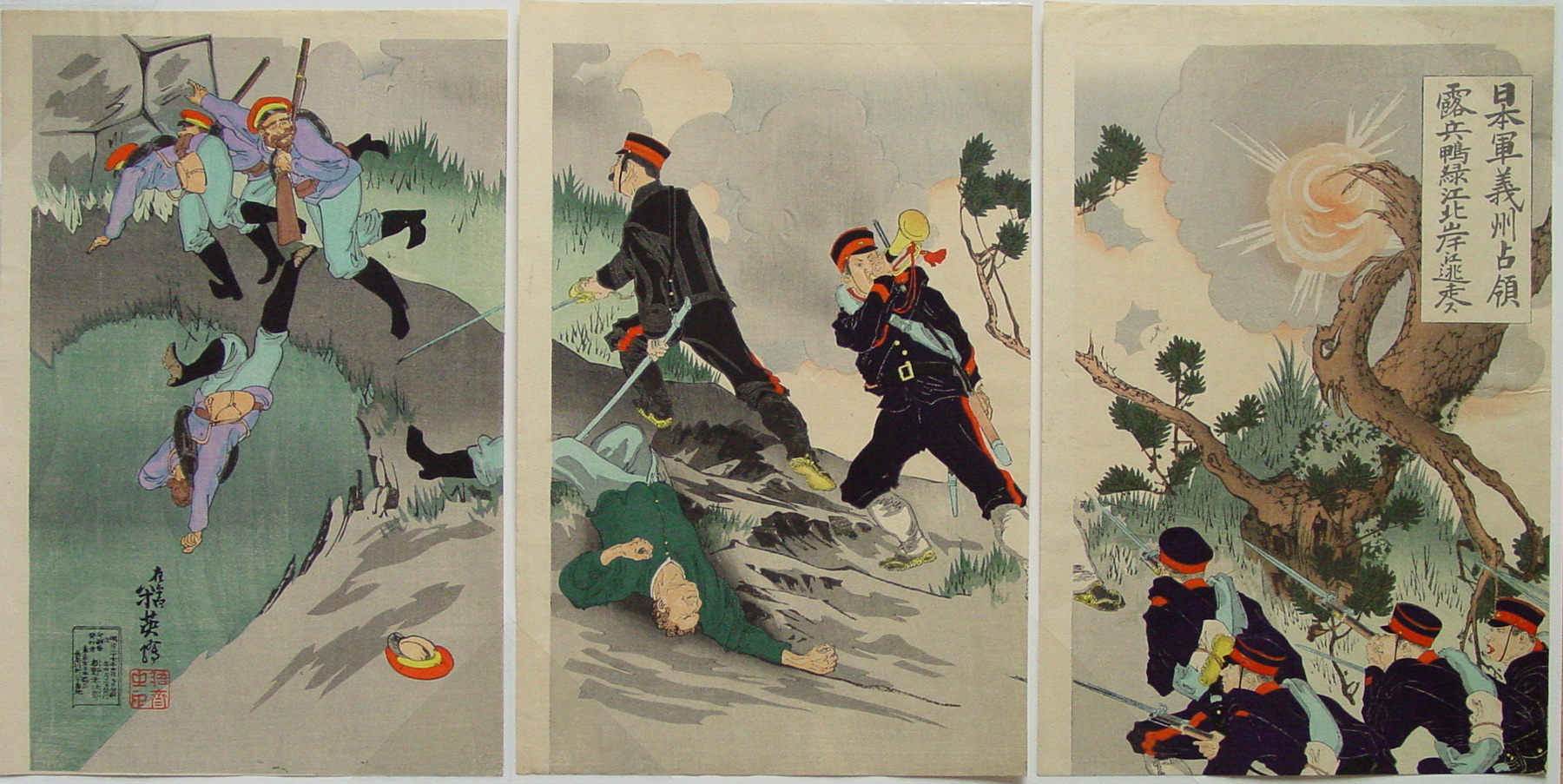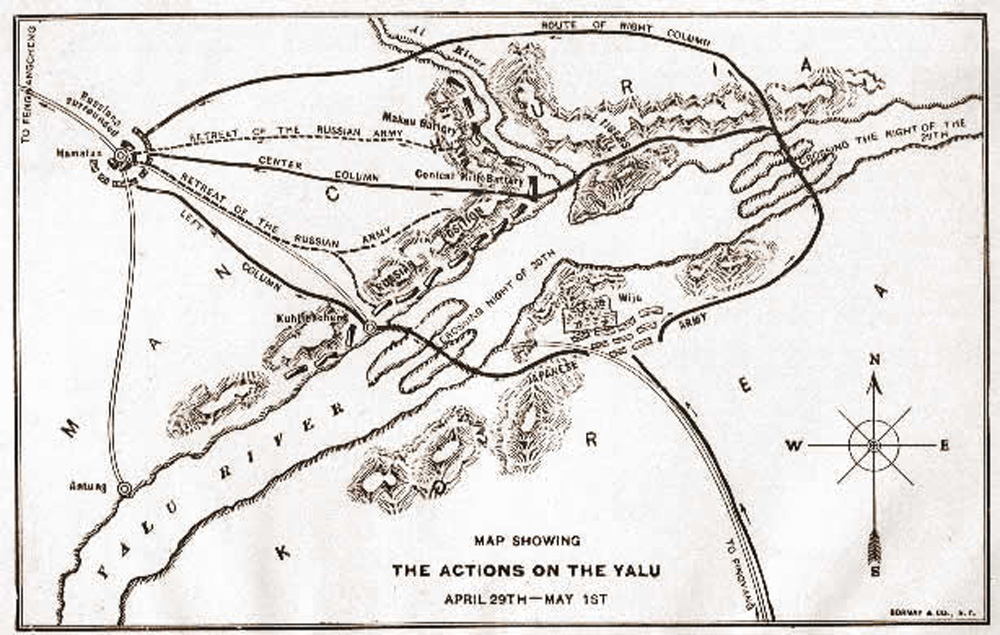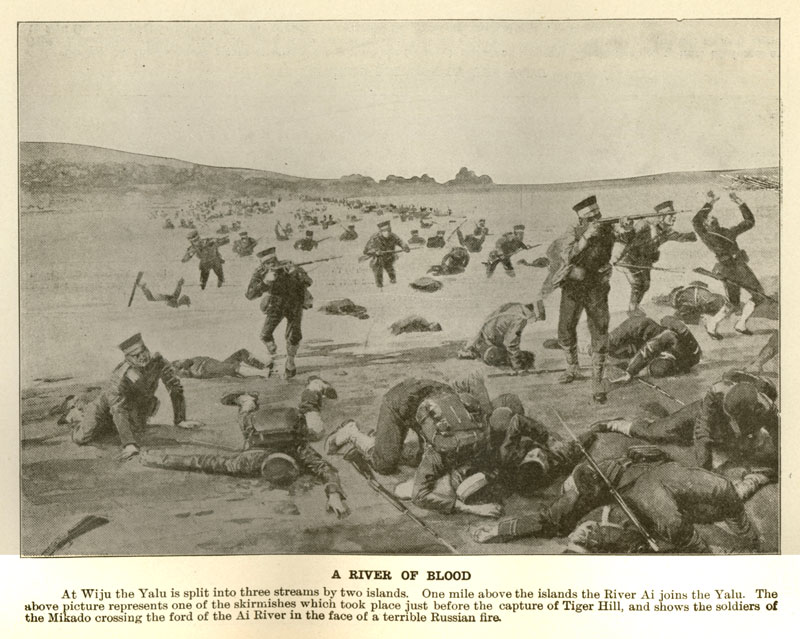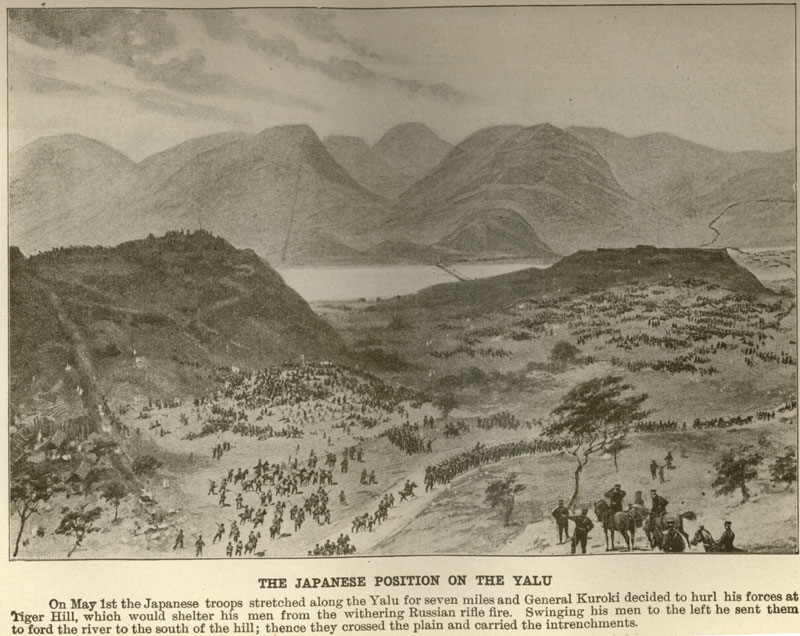About This Print
Source: University pf Delaware Gallery Collection website http://www.udel.edu/museums/gallery/archive/collections_pages/litt/litt-yonehide.html
The inscriptions on this print inform us that it depicts the Battle of the Yalu River* with Russian soldiers fleeing as Japanese forces took control of Yizhou, a town that is now part of North Korea. The fight for control of the Yalu River was a recurrent struggle of the Russo-Japanese War (1904-1905); the depicted skirmish is thought to have taken place on April 4, 1904, with the print being published only a few days thereafter (the inscription states that the print was prepared on April 9 and published April 12). This quick turnaround was made possible by the artist’s re-use of a woodblock originally used to depict a battle from the Sino-Japanese War of 1894-5 in which Japan struggled to overtake Taiwan and the Pescadores. (See images below.) With the diffusion of photography and lithography, most war reportage featured the new media of photoengraving rather than the more traditional woodblock prints, making this work a rare example.
*The Yalu River forms the border between China and North Korea.
Unabashed Plagiarism
Source: MIT Visualizing Cultures website http://ocw.mit.edu/ans7870/21f/21f.027/throwing_off_asia_03/toa_essay03.htmlA few of the new war prints involved outright and unabashed plagiarism from the earlier war. An 1895 Toshihide print depicting Captain Sakuma Raising a War Cry at the Occupation of the Pescadores resurfaced in 1904 as Russian Soldiers Fleeing to the North Bank of the Yalu River. The emperor’s valiant fighting men—officer with his sword, bugler, advancing troops—are identical. The gnarled pine is identical. The corpse sprawled face upwards in the foreground is identical, too—with the notable exception of having been transformed from a Chinese into a Russian. Only in the left-hand panel of the triptych does the artist of 1904 (his name is given as Yonehide, and he seems to have materialized out of the blue and blessedly disappeared that same year) add his own fleeing Russians.
| Migita Toshihide, 1895 Captain Sakuma Raising a War Cry at the Occupation of the Pescadores | Yonehide, 1904 Japanese Forces Occupying Yizhou. Russian Soldiers Fleeing to the North Bank of the Yalu |
The plagiarism, however, is mitigated by the same publisher, Matsuno Yonejirō, issuing both prints. The publisher's were the owner's of the actual woodblocks that were created by artisans in their employ.
Source: Official History of the Russian-Japanese War: A Vivid Panorama of Land and Naval Battles, J. Martin Miller, 1905, p. 351
"The moonlight night broke into a splendid dawn and revealed the Japanese army drawn up as if on parade. The Russians did not respond to the opening of the Japanese fire, but remained silent and invisible. The Japanese line of infantry, two miles long and entirely exposed, advanced from point to point by swift, sudden rushes, smartly executed in the most brilliant style, firing steadily all the while. We watched anxiously, anticipating that each rush would enter the zone of fire. The Japanese were working around the sides of Kiu-Lien Bay to their position when the Russian trenches suddenly poured a hurricane of rifle fire into them with deadly effect.
For a moment the Japanese advance weakened and recoiled, then rallied and once more rushed forward across the stream, obtaining some shelter in a dead angle under the base of the mountain. The Russians, not having guns, were unable to reply to the continuous fire of the Japanese artillery.
The Japanese advance was marked now by prostrate bodies. In one instance two Japanese shells did terrible execution among their own men, who were ascending the slope. Two hours after the advance began an officer suddenly appeared at the top of the slope waving a large Japanese flag, sending an electric thrill through the beholders, all far and near shouting 'Banzai.'"
last revision:
The Battle on the Yalu
The following is an eyewitness account of the battle of the Yalu River, from an unidentified observer with the Japanese forces:Source: Official History of the Russian-Japanese War: A Vivid Panorama of Land and Naval Battles, J. Martin Miller, 1905, p. 351
"The moonlight night broke into a splendid dawn and revealed the Japanese army drawn up as if on parade. The Russians did not respond to the opening of the Japanese fire, but remained silent and invisible. The Japanese line of infantry, two miles long and entirely exposed, advanced from point to point by swift, sudden rushes, smartly executed in the most brilliant style, firing steadily all the while. We watched anxiously, anticipating that each rush would enter the zone of fire. The Japanese were working around the sides of Kiu-Lien Bay to their position when the Russian trenches suddenly poured a hurricane of rifle fire into them with deadly effect.
For a moment the Japanese advance weakened and recoiled, then rallied and once more rushed forward across the stream, obtaining some shelter in a dead angle under the base of the mountain. The Russians, not having guns, were unable to reply to the continuous fire of the Japanese artillery.
The Japanese advance was marked now by prostrate bodies. In one instance two Japanese shells did terrible execution among their own men, who were ascending the slope. Two hours after the advance began an officer suddenly appeared at the top of the slope waving a large Japanese flag, sending an electric thrill through the beholders, all far and near shouting 'Banzai.'"
click on map to enlarge
Yalu Battle Map
Source: Official History of the Russian-Japanese War: A Vivid Panorama of Land and Naval Battles, J. Martin Miller, 1905
Illustration of the Japanese Position at the Yalu River
Source: Official History of the Russian-Japanese War: A Vivid Panorama of Land and Naval Battles, J. Martin Miller, 1905
Source: Official History of the Russian-Japanese War: A Vivid Panorama of Land and Naval Battles, J. Martin Miller, 1905
Print Details
| IHL Catalog | #101 |
| Title or Description | Japanese Forces Occupying Yizhou. Russian Soldiers Fleeing to the North Bank of the Yalu Nihon gun gishū senryō, rohei ōryokkō hokugan e tōsō su 日本軍義州占領露兵鴨緑江北岸江逃走ス |
| Artist | Yonehide (active 1904) |
| Signature |  |
| Seal | Gosei no in 梧斎之印 (as shown above) |
| Publication Date | April 12, 1904 (Meiji 37); Printing Date: April 9, 1904 (Meiji 37) |
| Publisher | 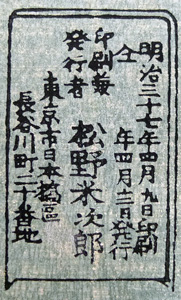 |
| Impression | excellent |
| Colors | excellent |
| Condition | excellent - full size, untrimmed sheets |
| Genre | ukiyo-e; senso-e (Russo-Japanese War) |
| Miscellaneous | |
| Format | vertical oban triptych |
| H x W Paper | 14 3/4 x 9 3/4 in. (37.5 x 24.8 cm) each sheet |
| Literature | In Battle's Light: Woodblock Prints of Japan's Early Modern Wars, Elizabeth de Sabato Swinton, Worcester Art Museum, 1991, p. 126, pl. 75 |
| Collections This Print | Museum of Fine Arts, Boston (2000.467); Collections Database Five Colleges and Historic Deerfield Museum Consortium AC 2001.649.1-.3 |
4/23/2020
3/7/2020


